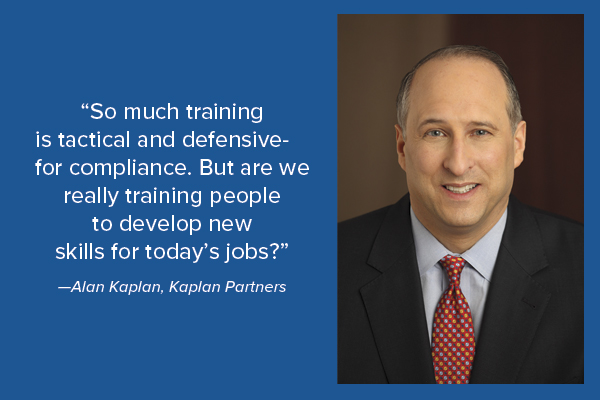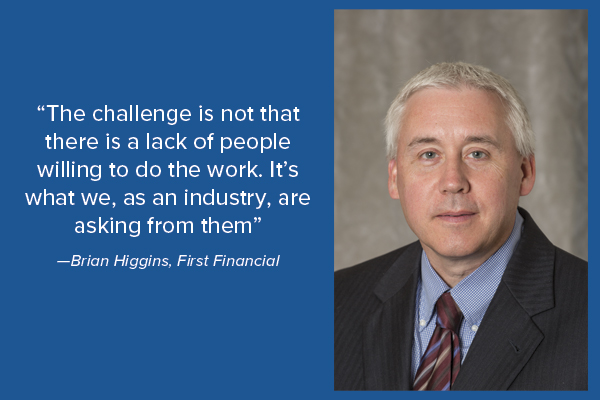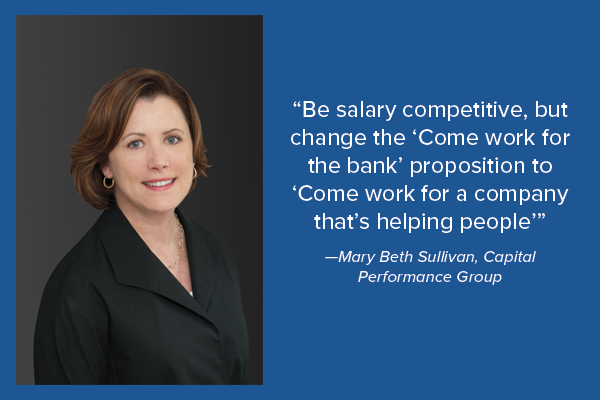Can your bank solve the skills puzzle?
As banks transform, employee skills don’t always keep up. Here's how to fill the gap
- |
- Written by Melanie Scarborough
 The work in banking is changing—the skiils, training, and pay of the workforce not always so much. Some banks have shifted strategies as a result.
The work in banking is changing—the skiils, training, and pay of the workforce not always so much. Some banks have shifted strategies as a result.
Banks of all stripes are changing. Branches that aren’t closed are remaking their looks and functioning faster. Because many transactions can be performed online, customers who come into the bank often bring complex questions that frontline employees need the knowledge to address.
Then, too, after a decade of sluggish economic growth, and post-crisis focus on compliance and risk management, bank employees may be out of practice in sales.
Digital technology is transforming the industry, making it a good fit for tech-savvy millennials, who bring novel career expectations that banks must manage.
Banks know that upgrading skills is critical, but the industry faces specific challenges.
Employee training is often regulation-driven, leaving little time and resources—especially for community banks—to teach skills that drive profit.
Further, a career in banking no longer holds much allure for young people. Finding skilled workers can be particularly difficult in small towns where the hiring pool is limited.
The problem is not merely geographic or unique to small banks.
Patrick Harker, president of the Federal Reserve Bank of Philadelphia, said in a speech earlier this year: “Something I’ve heard over and over again from businesses of all sizes is that they have the jobs; they just can’t find the people. There seems to be a skills void that can’t be filled by the existing workforce.”
Wanted: rainmakers
The void is most acute among employees who can bring in revenue, according to Alan Kaplan, founder and CEO of Philadelphia-based Kaplan Partners.
“If you’re in any market—small town or major city—you’re having trouble finding good lenders, business bankers,” Kaplan says. In a recent meeting with 35 bank CEOs, Kaplan says they reported that their biggest struggle was finding lenders to help grow their loan portfolios.
“We have a big hole in the training of commercial lenders and commercial bankers that is probably a 15-year gap,” he says. “Supply and demand are way out of whack.”
One reason is regulatory hurdles.
“After the crisis ten years ago, bank hires became more concentrated in nonrevenue staff jobs—particularly those related to risk and technology, as a result of transformation of the industry,” Kaplan explains. “If you’re constrained on expenses and regulators are scrutinizing you, you have to placate them with extra hires before they allow you to grow.”
The result: Many banks don’t have enough employees in jobs that bring in revenue, and those they do have may be inexperienced or out of practice.

The president of one of the nation’s largest banks, speaking on background, says that nearly two-thirds of his employees were hired in the moribund years since 2008, so they have almost no experience in selling investment products. Now that the economy is recovering and customers are interested in annuities and bonds, employees must be trained in skills they may have never used.
Mary Beth Sullivan, managing partner at Capital Performance Group, Washington, D.C., says, “The investments issue is just a part of the bigger challenge: transforming frontline staff into true customer relationship managers capable of calling on subject-matter experts—an investment advisor, a small business specialist—when that is what the client needs.”
Frontline most valuable players
The need for frontline employees to be jacks-of-all-trades requires another set of skills.
Brian Higgins, first vice-president, digital, payments and innovation for $8.4 billion-assets First Financial Bank, Cincinnati, says: “The challenge is not that there is a lack of people willing to do the work. The challenge is, as an industry, what we’re asking from them at physical locations. They need to be—maybe not experts—but have enough knowledge around all the solutions the bank offers as customers bring them more complex questions.”
That requires the skill to decipher what the customer needs, even when the customer can’t clearly articulate it.
“As basic transactions are moving to other channels, branch representatives are being asked to focus on higher-valued sales and more complex financial solutions, both consumer and commercial,” Higgins says. “They need to be able to tap into all the solutions we offer right that minute. That’s really hard.” He suspects most banks don’t provide enough tools.

One that tries to do so is Fifth Third Bank, the $142 billion-asset super regional, also based in Cincinnati. Christine Nester, senior vice-president and chief learning officer, says the bank recognizes that as branch functions change, employee skills must adjust.
“The digital world is transforming how we build talent the same way it’s transforming the way we work with customers,” she says. Like Higgins, Nester says frontline employees need to be knowledgeable beyond defined roles.
“That nimble skill set, that agility, is critical,” she says. “That’s what we look for in talent.” To foster agility, Fifth Third emphasizes the importance of continual learning, rather than waiting for annual training.
Fifth Third also looks for the willingness to learn among candidates for its college leadership program, which recruits individuals for internships and two-year rotations at the bank. An encouraging sign is that young workers want to know how to improve.
“They’re not waiting for an annual performance review to see how they’re doing and what they can do to advance,” Nester says. “They’re very interested in instructional feedback—much more so than previous generations.”
Working with colleges also helps the bank find skill sets across various business lines. “As the environment changes and we stay connected to universities—following what are the popular majors like cybersecurity—we try to recruit new talent in those areas,” Nester says.
Hire what you need
The Bank of New Jersey, headquartered in Fort Lee, with $872 million in assets, takes a unique approach to finding skilled employees: It hires only tellers who have been tellers elsewhere.
“We don’t bring them in from the ground up,” says President and CEO Nancy Graves. “That’s a benefit because they’re already very knowledgeable.” The bank cross-trains employees so they can fill many roles.
Because of its proximity to New York City, the bank needs employees skilled in the discernment that comes with experience.
“The standard of knowing who you’re dealing with and the source of their funds, that rests on tellers and platform people to have that knowledge and pay close attention,” Graves says. “If a customer comes here and passed 20 banks to get to us, the first question is, ‘Why us?’ They may think we’re inexperienced and don’t know how to spot high-risk business.”
After hiring people who already have skills, the Bank of New Jersey works to keep them.
“We’re a little different from other banks,” Graves says. “We pay better, and we have a bonus program that’s not based on selling. If we have a good year and people are working hard, they get rewarded for that.”

One of the first things Graves did after becoming president and CEO a year ago was to ask the board of directors to offer stock options to all employees after they vested over three years. “They need to know they’re sharers in this bank,” she says.
The bank also has done a tremendous amount of internal promotion. “They don’t have to leave to get a better job,” Graves says. “That job is going to be here. We put people in accounting who started out in a branch, and they’re invaluable because they understand how everything works.”
State Bank of Countryside, Countryside, Ill., did a total remake of all its branches about three years ago.
“We went from traditional to modern or ‘millennial’ as some people call it,” says Thomas Boyle, vice-chairman of the $565 million-assets bank. The branches have two cash exchanges manned by fairly young employees. “We are looking for not only analytical ability, but for some sales skills as well,” Boyle says. Young employees with sales skills are more difficult to find. “Actually, our best results have been stealing them from other institutions,” he points out.
Mining for new skills
Hiring employees who bring new skills to the bank is one solution. Another is finding untapped skills in current employees. Nester says it’s a myth that older employees struggle with new banking technology because that’s not the way they learned originally.
“Think how we live personally,” says Nester. “All of us baby boomers use our cell phones and apps constantly.” The transition for these bankers has been no more difficult in their professional lives.
Yet no matter how adept 50 year-old employees become in banking technology, most will not have the proficiency in social media that is second nature to younger workers—and important to learn as banks increasingly market there. Cross-training can prove helpful.
“Young folks are used to a rapidly changing digital environment; what they’re less familiar with is banking,” Capital Performance Group’s Sullivan says. “Some banks have reverse-mentoring programs, where executives are paired with young people to learn how to interact with their peers in a digital way. It can be powerful.”
One hindrance to skill development that banks should watch out for is that “regulation drove banking to become an industry of specialists,” says Kaplan of Kaplan Associates. Too many employees stay in one area far too long, becoming experts in a particular slice of the bank, but never developing the skills they need to take responsibility across lines.
Some banks sabotage themselves with hierarchical structures that keep skilled workers on the shelf.
“We baby boomers started our careers when there were fairly exacting expectations for how long you might be in a role and when you could move up,” Sullivan says. “For younger folks, career paths have to be flexible.”
Today’s skilled workers will move on if banks are too rigid about advancement opportunities.
“The mind-set [of] ‘I’ve been here five years and he’s been here two years; I should be given that chance.’ We need to rethink that,” Sullivan points out.
Kaplan sees the problem particularly in veteran managers, aged 50 and older, supervising employees in their 30s who want to be constantly challenged with more responsibility.
“You have the up-and-comer working for someone who says, ‘It took me 20 years to be a manager; why does she want to do it in five?’”
But if an employee has skills, it is a mistake to make her wait. “Millennials get a knock for moving around a lot,” Kaplan adds, “but employers are just as much at fault for not managing a different kind of employee than they’ve ever had to manage before.”
Malysa O’Connor, senior director of financial services at Kronos Inc., says managing and cultivating employees is difficult because so many generations—each with different experiences, cultural milieus, and economic histories—are now coexisting in the workforce:
• “Baby boomers have more of a live-to-work mentality,” she says. “Gen Xers want more of a work-life balance.
• “Millennials want to do things they feel have purpose—maybe not the highest-paying job, but one where they can give back to their community.
• “Generation Z, those just entering the workforce, are all about instant gratification. How do you manage a workforce where values are so vastly different?”
While most attention is given to managing younger employees, O’Connor says it’s just as important to develop skills in your bank’s leaders. “The number one reason people leave jobs is because of their managers,” she says. “You’d hate to lose a really great employee because they don’t like their manager.”
Train for value
First Financial reinstituted its management training program two years ago, partly because of the challenge of finding the employee skills it needed. An enhancement of the previous program, this one is built around helping participants understand all facets and features of how the bank delivers value.
“We use a seven-week program where they’re challenged with coming up with all the decisions to help them understand the implications of business results,” Higgins explains. “How did clients respond to that? What does that do to our bottom line? They have to make the decisions to really run a business and have the feedback to see how their decisions can serve clients.”
More banks could benefit from such instruction and likely would if they didn’t have to spend so much time training for compliance. “So much of it is tactical and defensive,” Kaplan says. “But are we really training people for new jobs to the extent that we could help people develop new skills? Some banks do a good job; others have room for improvement.”
Sullivan says when Capital Performance Group helps clients train teams, they teach them to remind employees that although they’re in a regulated environment with significant responsibility, they can still function in innovative, customer-centric ways.
“Regulations are inherently designed to address safety and soundness because we’re in the business of managing risks,” she says. “But that doesn’t preclude us from building very strong value propositions that essentially help businesses and families to operate and become more financially strong and optimize their cash flow. It’s not about products; it’s about what you’re going to do for the client.”
Millennial appeal
While the skills banks need have changed, recruitment hasn’t always kept pace.
“We’re still running ads in the newspaper saying, ‘Must be good at adding and subtracting,’ instead of saying, ‘If you want to work for a technology-driven business that gives back to its community, then come talk to us,’” Kaplan says. “Millennials’ key drivers are technology, community, and customer. There’s no industry that is more committed to communities than banking—none.”
To attract skilled workers, banks also need to promote flexibility in career paths. Silos in banking often keep them from developing talent, and that hurts the recruiting process, Sullivan says. “A lot of kids are finance majors, but they think, ‘I don’t want to be a bank teller.’ There’s a lot that can be done, even in universities, to change that perspective.”
Like Kaplan, Sullivan says recruitment should focus on what banks do for their communities.

“You have to be competitive with salaries, but the key is you have to change the proposition from ‘Come work for the bank’ to ‘Come work for a company that’s helping people.’ You don’t have to match Wall Street salaries because you’re offering something different.”
Fifth Third makes that a cornerstone of its approach to college students. Recruiters explain that not only does the bank allow time for community service, such service is expected of employees—a value that Nester says resonates.
Malysa O’Connor says rebranding may be needed. “Jobs that were attractive 20 years ago because they had high salaries are not attractive to millennials,” she says. “They’re looking more for purpose.”
Money and reputation
Clearly, to recruit young, tech-savvy, purpose-driven workers, banks must compete with nonbank entities, online companies, and start-ups. But Nester finds that prospective hires are looking at a broad range of opportunities in a broad range of industries.
“We’re still able to find those people, but they’re a highly sought-after group,” Nester says.
State Bank of Countryside’s Boyle agrees that “it’s an employees’ market at the moment.” One of the challenges, he says, is that hiring today is not only about whether prospective employees can meet the bank’s requirements, but whether the bank can meet theirs. “They want to know about shorter hours, how quickly they can advance. It’s a little unusual to be asked that of a person right out of school,” he says.
O’Connor says some of the banks she has talked to are finding talent by hiring more part-time workers or having pools of different workers. That can bring in employees, such as mothers and college students, who may have good skills but can’t commit to full-time work.
Broadening the workforce also can address a common complaint she hears: It’s hard to find people willing to work the new “bankers’ hours” because one of the changes many branches have made is to stay open evenings and weekends.
Sullivan says if she were running a bank, she would make clear to potential employees that the job is about much more than time and position. It’s about how much they can accomplish within the company, and the ample opportunities for advancement.
“We are an industry going through a substantial change,” she says. “We want the people coming in on frontline positions to have people skills, but we have to make sure we’re giving them the opportunity to use those skills in new and exciting ways. Banks haven’t done the best job conveying that a career in our industry can be an incredibly rewarding one.”
For new hires in First Financial banking centers, Higgins generally relies on employee referrals. To fill backoffice roles, he taps into contacts he made during his career in financial services before being recruited by the bank four years ago. “I’ve had the opportunity to build a large network in financial services and help influence and educate,” he says.
Nonetheless, finding and developing the right skill sets remains a significant and universal challenge. “Almost every bank I talk to says transactions are declining as people move to digital channels,” Higgins says. “If that’s the case, you need to be looking at your talent a lot differently. Recruiting, teaching, managing—it’s all different than ten years ago when branches were more transaction-based.”
“At our bank, we’ve recognized and addressed this,” Higgins adds. “We make sure our employees are successful for us and successful for our customers.”
Read Ed O’Leary’s blog, “Do you want to “work big” or “work small”?
Read Melanie Scarborough’s earlier human resources article, “Star Search Success”
This article originally appeared in the April-May 2017 Banking Exchange magazine.
Tagged under Human Resources, Management, Duties, Community Banking,
Related items
- Wall Street Looks at Big Bank Earnings, but Regional Banks Tell the Story
- CFPB’s Auto Finance Data Collection Proposal Faces Backlash
- JP Morgan Drops Almost 5% After Disappointing Wall Street
- Banks Compromise NetZero Goals with Livestock Financing
- Consumers Seek Increased Online Safety Training from Banks














